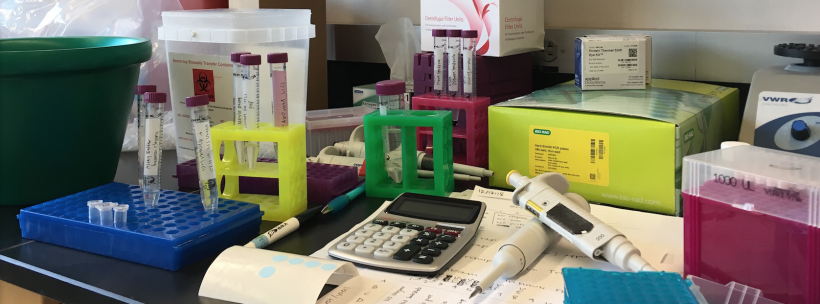20.109(S19):Purify phage-based active (cathode) material (Day2)
Contents
Introduction
Biomineralization is a process by which living organisms generate minerals that are often used to harden soft tissues. In our work for module 3 we are using M13 as a template for the biomineralization of phosphate to be used in your Li(FePO4) cathode.

The use of M13 as a 'scaffold' for this reaction is also termed biotemplating. Biotemplating utilizes biological materials to fabricate and/or organize unique nanomaterial structures. A variety of benefits are associated with biotemplated synthesis methods over traditional synthesis methods. From the fabrication standpoint, biotemplating can reduce the environmental impact of materials synthesis. Biotemplating has been shown to enable synthesis of materials at lower temperatures and pressures as well as using milder reagents than traditional synthesis methods. From the standpoint of organization, biotemplating can achieve unique structures over broad length scales. These structures are either unattainable or significantly more difficult to create without biotemplating.
Protocols
Part 1: BE Communication Lab workshop
Our communication instructors, Dr. Sean Clarke and Dr. Prerna Bhargava, will join us today to provide some tips for your research proposal presentation.
Part 2: Collect active material (nanowires)
In your flasks are the Fe(III)-phage-NP biomineralized nanowires that will serve as the active material in your battery cathodes. Today you will isolate and wash this material.
- Retrieve your flasks with your Fe(III)-phage-NP nanowires from the front bench.
- Gather the nanowires that adhered to the side of your flask.
- Use a P1000 pipet to 'waterfall' the culture liquid from your flask down the sides of the flask.
- Divide the liquid in your flask equally between three 50 mL conical tubes.
- Be sure to clearly label your tubes with a marker as stickers will come off in the centrifuge.
- Centrifuge at 3,250 rpm for 20 minutes.
- Decant the supernatant in the sink.
- Carefully remove any residual liquid with your P1000.
- Resuspend your pellet in diH2O.
- Add 2 mL of diH2O and mix by pipetting up and down ~10 times.
- Continue adding 1-2 mL aliquots of diH2O and pippetting to mix until you reach a final volume of 4 mL in each tube.
- Transfer the resuspended nanowires from the 50 mL conicals into two 15 mL conicals (the liquid from three 50 mL conicals will be combined into one 15 mL conical).
- Be sure to clearly label your tube.
- Centrifuge at 3,250 rpm for 20 minutes.
- Decant the supernatant in the sink.
- Resuspend your pellet in 10 mL diH2O.
Part 3: Prepare TEM grid with nanowires
Each group should prepare two TEM grids for each cathode preparaion: both with nanowire solution. You will visualize your nanowires on M3D4 with Prof. Belcher and Jifa Qi at the Koch TEM facility.
- Vortex the nanowire pool for at least 1 minute and immediately remove 10 μL of the nanowire suspension to place on the silver/black side (not the copper-looking side) of the TEM grid that you have balanced in the tension tweezers. Treat the grid with care and use the tweezers only on the edge to minimize damaging the delicate mesh.
- Quickly repeat step 1 with the second TEM grid.
- Allow the nanowires to settle onto the grid undisturbed for 10 minutes.
- Remove the droplets of water from the grids by touching the edges with a Kimwipe, thereby wicking the solution off the grid.
- Wash the grids by adding 10 μL of sterile water onto each grid.
- Allow the grids to sit with water for 1-3 minutes and then wick dry.
- Wash the grids by adding 10 μL of 100% EtOH onto each grid.
- Allow the grids to sit with EtOH for 1-3 minutes and then wick dry, if it hasn't air dried.
- Place the grids into the TEM grid holder for safe transport to the Koch TEM facility.
Part 4: Dry active material (nanowires)
To further prepare your nanowires for use in your battery, this active material will be dried at high temperature to remove all liquid.
- Centrifuge your resuspended nanowires from Part 3 at 3,250 rpm for 20 minutes.
- Decant the supernatant in the sink.
- Carefully remove any residual liquid with your P200.
- Cover your tube with aluminum foil and punch a small hole in the top.
- Bring your tube tube to the front bench.
Your tubes will be transported to the Belcher Laboratory and will be placed in a vacuum drying oven at 80°C.
Reagents
- Copper film TEM grids (400 mesh) from Electron Microscopy Sciences
- 100% ethanol
Next day: Construct cathode with phage-based active material
Previous day: Grow phage-based active (cathode) material
